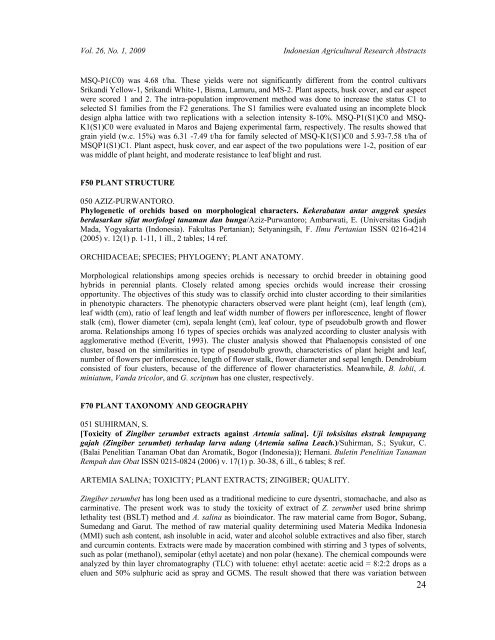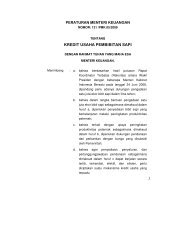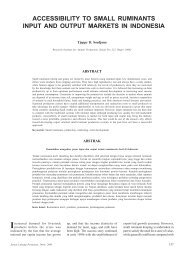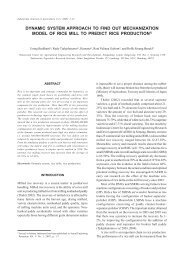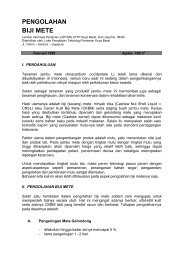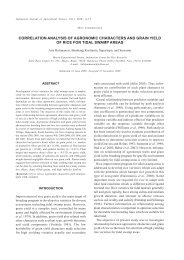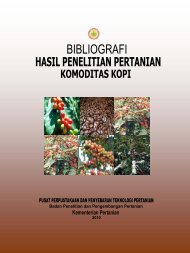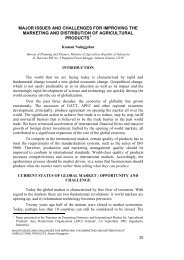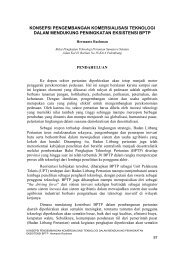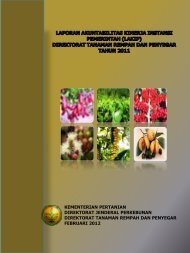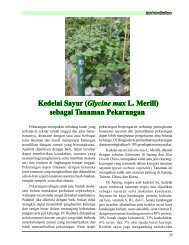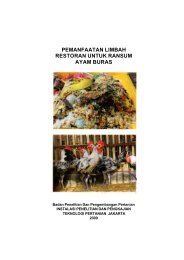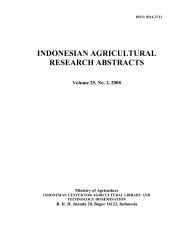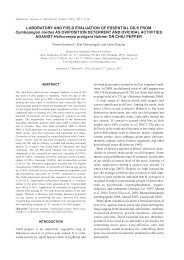Indonesian Agricultural Research Abstracts <strong>Vol</strong>. 26, <strong>No</strong>. 1, <strong>2009</strong>047 SUPRIYANTO, A.Genotype analysis of vegetatively propagated of citrus using RAPD primers. Analisis genotip pohoninduk jeruk bebas penyakit hasil perbanyakan tunas pucuk dengan primer RAPD/Supriyanto, A.;Agisimanto, D.; Purbiati, T.; Devy, N.F.; Dwiastuti, M.E. (Loka Penelitian Tanaman Jeruk danHortikultura Subtropik, Batu, Malang (Indonesia)). Jurnal Hortikultura ISSN 0853-7097 (2006) v. 16(1)p. 1-4, 1 ill., 15 ref.CITRUS SINENSIS; CITRUS GRANDIS; RAPD; VIRUSFREE PLANTS; MERISTEM CULTURE;GRAFTING.Accurate variety testing is needed to proof the genotype accuracy of virus free mother plant thatvegetatively multiplied. Study was done to analyze the genotype similarity of the kind mother plantthrough shoot tip grafting from the single mother plant by using DNA RAPD marker. Leaves from youngflush of 20-25 days were extracted in order to find out the bulk DNA. Each DNA sample from eachvariety was amplified by 2 RAPD primer and separated electrophoretically. The results indicated that 2RAPD OPN14 and OPN16 primer revealed the uniformity of DNA band of the breeder seeds and themother plant. The results strongly confirmed that there was no genotype differences among the plantgenerated from standard protocol of producing virus free of citrus breeder seeds and the single motherplant.048 WICAKSANA, N.Multivariate analysis on flowers and leaves characters of three yam bean species (Pachyrhizus spp.)population. Analisis multivariat karakter bunga dan daun pada populasi tiga spesies bengkuang(Pachyrhizus spp.)/Wicaksana, N.; Karuniawan, A. (Universitas Padjadjaran, Jatinangor, Sumedang(Indonesia). Fakultas Pertanian). Bionatura ISSN 1411-0903 (2006) v. 8(2) p. 171-181, 2 ill., 4 tables; 19ref.PACHYRHIZUS; SPECIES; FLOWERS; LEAVES; GENOTYPES;STATISTICAL METHODS; AGRONOMIC CHARACTERS.CROP PERFORMANCE;The objective of this study was to analyze flowers and leaves morphological characters of three yam beanspecies (P. erosus, P. ahipa, and P. tuberosus) in Jatinangor West Java. Twelve P. erosus genotypes, sixP. ahipa genotypes, and four P. tuberosus genotypes were planted on randomized block design with tworeplications. Multivariate analysis, i.e. principal component and cluster analysis was used to grouping thethree species of yam bean based on 18 characters of flowers and leaves performances. Both principalcomponent and cluster analysis clearly separated the three species. The analysis showed that identificationof floral variables was the main character to discriminate between species.049 YASIN H.G., M.Intra-population improvement of quality protein maize MSQ-K1 and MSQ-P1. Perbaikan populasijagung QPM MSQ-K1(S1)C0 dan MSQ-P1(S1)C0/Yasin H.G., M.; Arifuddin; Mejaya M.J. (BalaiPenelitian Tanaman Serealia, Maros (Indonesia)). Penelitian Pertanian Tanaman Pangan ISSN 0216-9959 (2005) v. 24(3) p. 140-146, 8 tables; 13 ref.ZEA MAYS; PLANT POPULATION; HIGH YIELDING VARIETIES; SELECTION; AGRONOMICCHARACTERS.MSQ-P1 and MSQ-K1 were two quality protein maize (QPM) populations with white and yellow graincolours, respectively. The intra-population improvement was done to increase the grain yields of bothQPMs. The variety trial on a C0 cycle was conducted in Blora, Central Java, during the planting season ofJune-October 2004. A randomized completely block design with three replications was used in theexperiment. Each entry was planted in a four-rows plot at a plant spacing of 75 cm x 25 cm, one plant perhill. Results of the trial showed that grain yield (m.c. 15%) of the MSQ-K1(C0) was 4.76 t/ha, while23
<strong>Vol</strong>. 26, <strong>No</strong>. 1, <strong>2009</strong>Indonesian Agricultural Research AbstractsMSQ-P1(C0) was 4.68 t/ha. These yields were not significantly different from the control cultivarsSrikandi Yellow-1, Srikandi White-1, Bisma, Lamuru, and MS-2. Plant aspects, husk cover, and ear aspectwere scored 1 and 2. The intra-population improvement method was done to increase the status C1 toselected S1 families from the F2 generations. The S1 families were evaluated using an incomplete blockdesign alpha lattice with two replications with a selection intensity 8-10%. MSQ-P1(S1)C0 and MSQ-K1(S1)C0 were evaluated in Maros and Bajeng experimental farm, respectively. The results showed thatgrain yield (w.c. 15%) was 6.31 -7.49 t/ha for family selected of MSQ-K1(S1)C0 and 5.93-7.58 t/ha ofMSQP1(S1)C1. Plant aspect, husk cover, and ear aspect of the two populations were 1-2, position of earwas middle of plant height, and moderate resistance to leaf blight and rust.F50 PLANT STRUCTURE050 AZIZ-PURWANTORO.Phylogenetic of orchids based on morphological characters. Kekerabatan antar anggrek spesiesberdasarkan sifat morfologi tanaman dan bunga/Aziz-Purwantoro; Ambarwati, E. (Universitas GadjahMada, Yogyakarta (Indonesia). Fakultas Pertanian); Setyaningsih, F. Ilmu Pertanian ISSN 0216-4214(2005) v. 12(1) p. 1-11, 1 ill., 2 tables; 14 ref.ORCHIDACEAE; SPECIES; PHYLOGENY; PLANT ANATOMY.Morphological relationships among species orchids is necessary to orchid breeder in obtaining goodhybrids in perennial plants. Closely related among species orchids would increase their crossingopportunity. The objectives of this study was to classify orchid into cluster according to their similaritiesin phenotypic characters. The phenotypic characters observed were plant height (cm), leaf length (cm),leaf width (cm), ratio of leaf length and leaf width number of flowers per inflorescence, lenght of flowerstalk (cm), flower diameter (cm), sepala lenght (cm), leaf colour, type of pseudobulb growth and floweraroma. Relationships among 16 types of species orchids was analyzed according to cluster analysis withagglomerative method (Everitt, 1993). The cluster analysis showed that Phalaenopsis consisted of onecluster, based on the similarities in type of pseudobulb growth, characteristics of plant height and leaf,number of flowers per inflorescence, length of flower stalk, flower diameter and sepal length. Dendrobiumconsisted of four clusters, because of the difference of flower characteristics. Meanwhile, B. lobii, A.miniatum, Vanda tricolor, and G. scriptum has one cluster, respectively.F70 PLANT TAXONOMY AND GEOGRAPHY051 SUHIRMAN, S.[Toxicity of Zingiber zerumbet extracts against Artemia salina]. Uji toksisitas ekstrak lempuyanggajah (Zingiber zerumbet) terhadap larva udang (Artemia salina Leach.)/Suhirman, S.; Syukur, C.(Balai Penelitian Tanaman Obat dan Aromatik, Bogor (Indonesia)); Hernani. Buletin Penelitian TanamanRempah dan Obat ISSN 0215-0824 (2006) v. 17(1) p. 30-38, 6 ill., 6 tables; 8 ref.ARTEMIA SALINA; TOXICITY; PLANT EXTRACTS; ZINGIBER; QUALITY.Zingiber zerumbet has long been used as a traditional medicine to cure dysentri, stomachache, and also ascarminative. The present work was to study the toxicity of extract of Z. zerumbet used brine shrimplethality test (BSLT) method and A. salina as bioindicator. The raw material came from Bogor, Subang,Sumedang and Garut. The method of raw material quality determining used Materia Medika Indonesia(MMI) such ash content, ash insoluble in acid, water and alcohol soluble extractives and also fiber, starchand curcumin contents. Extracts were made by maceration combined with stirring and 3 types of solvents,such as polar (methanol), semipolar (ethyl acetate) and non polar (hexane). The chemical compounds wereanalyzed by thin layer chromatography (TLC) with toluene: ethyl acetate: acetic acid = 8:2:2 drops as aeluen and 50% sulphuric acid as spray and GCMS. The result showed that there was variation between24
- Page 5: Vol. 26, No. 1, 2009Indonesian Agri
- Page 8 and 9: Indonesian Agricultural Research Ab
- Page 10 and 11: Indonesian Agricultural Research Ab
- Page 13 and 14: Vol. 26, No. 1, 2009Indonesian Agri
- Page 15 and 16: Vol. 26, No. 1, 2009Indonesian Agri
- Page 17 and 18: Vol. 26, No. 1, 2009Indonesian Agri
- Page 19 and 20: Vol. 26, No. 1, 2009Indonesian Agri
- Page 21 and 22: Vol. 26, No. 1, 2009Indonesian Agri
- Page 23 and 24: Vol. 26, No. 1, 2009Indonesian Agri
- Page 25 and 26: Vol. 26, No. 1, 2009Indonesian Agri
- Page 27: Vol. 26, No. 1, 2009Indonesian Agri
- Page 31 and 32: Vol. 26, No. 1, 2009Indonesian Agri
- Page 33 and 34: Vol. 26, No. 1, 2009Indonesian Agri
- Page 35 and 36: Vol. 26, No. 1, 2009Indonesian Agri
- Page 37 and 38: Vol. 26, No. 1, 2009Indonesian Agri
- Page 39 and 40: Vol. 26, No. 1, 2009Indonesian Agri
- Page 41 and 42: Vol. 26, No. 1, 2009Indonesian Agri
- Page 43 and 44: Vol. 26, No. 1, 2009Indonesian Agri
- Page 45 and 46: Vol. 26, No. 1, 2009Indonesian Agri
- Page 47 and 48: Vol. 26, No. 1, 2009Indonesian Agri
- Page 49 and 50: Vol. 26, No. 1, 2009Indonesian Agri
- Page 51 and 52: Vol. 26, No. 1, 2009Indonesian Agri
- Page 53 and 54: Vol. 26, No. 1, 2009Indonesian Agri
- Page 55 and 56: Vol. 26, No. 1, 2009Indonesian Agri
- Page 57 and 58: Vol. 26, No. 1, 2009Indonesian Agri
- Page 59 and 60: Vol. 26, No. 1, 2009Indonesian Agri
- Page 61 and 62: Vol. 26, No. 1, 2009Indonesian Agri
- Page 63 and 64: Vol. 26, No. 1, 2009Indonesian Agri
- Page 65 and 66: Vol. 26, No. 1, 2009Indonesian Agri
- Page 67 and 68: Vol. 26, No. 1, 2009Indonesian Agri
- Page 69 and 70: Vol. 26, No. 1, 2009Indonesian Agri
- Page 71 and 72: Vol. 26, No. 1, 2009Indonesian Agri
- Page 73 and 74: Vol. 26, No. 1, 2009Indonesian Agri
- Page 75 and 76: Vol. 26, No. 1, 2009Indonesian Agri
- Page 77 and 78: Vol. 26, No. 1, 2009Indonesian Agri
- Page 79 and 80:
Vol. 26, No. 1, 2009Indonesian Agri
- Page 81 and 82:
Vol. 26, No. 1, 2009Dickinson, M.J.
- Page 83 and 84:
Vol. 26, No. 1, 2009Indonesian Agri
- Page 85 and 86:
Vol. 26, No. 1, 2009Indonesian Agri
- Page 87 and 88:
Indonesian Agricultural Research Ab
- Page 89 and 90:
Indonesian Agricultural Research Ab
- Page 91 and 92:
Indonesian Agricultural Research Ab
- Page 93 and 94:
Indonesian Agricultural Research Ab
- Page 95 and 96:
Indonesian Agricultural Research Ab
- Page 97 and 98:
Indonesian Agricultural Research Ab
- Page 99:
Indonesian Agricultural Research Ab


